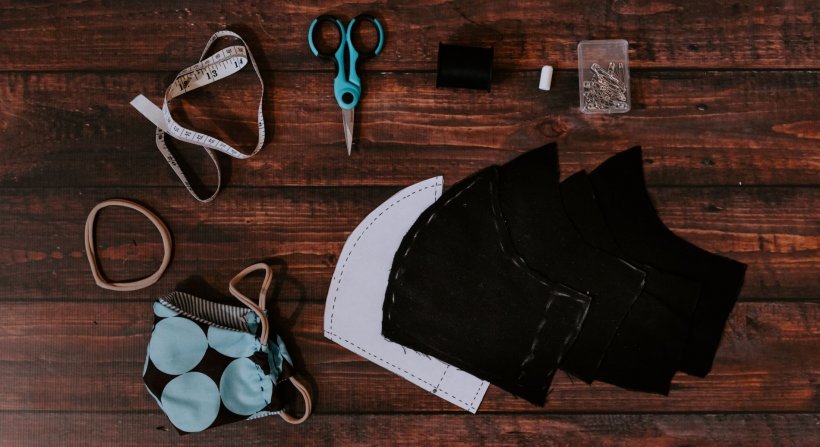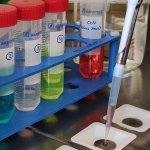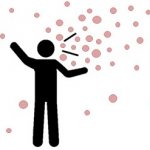
Image source: Unsplash/Kelly Sikkema
News • Coronavirus protection
COVID-19: The best (and worst) materials for masks
It's intuitive and scientifically shown that wearing a face covering can help reduce the spread of the novel coronavirus that causes COVID-19. But not all masks are created equal, according to new University of Arizona-led research.
Amanda Wilson, an environmental health sciences doctoral candidate in the Department of Community, Environment and Policy in the Mel and Enid Zuckerman College of Public Health, is lead author on a recent study published in the Journal of Hospital Infection that assessed the ability of a variety of nontraditional mask materials to protect a person from infection after 30 seconds and after 20 minutes of exposure in a highly contaminated environment.

Image source: University of Arizona
When the researchers compared wearing masks to wearing no protection during 20-minute and 30-second exposures to the virus, they found that infection risks were reduced by 24-94% or by 44-99% depending on the mask and exposure duration. Risk reduction decreased as exposure duration increased, they found. "N99 masks, which are even more efficient at filtering airborne particles than N95 masks, are obviously one of the best options for blocking the virus, as they can reduce average risk by 94-99% for 20-minute and 30-second exposures, but they can be hard to come by, and there are ethical considerations such as leaving those available for medical professionals," Wilson said.
The next best options, according to the research, are N95 and surgical masks and, perhaps surprisingly, vacuum cleaner filters, which can be inserted into filter pockets in cloth masks. The vacuum filters reduced infection risk by 83% for a 30-second exposure and 58% for a 20-minute exposure. Of the other nontraditional materials evaluated by the researchers, tea towels, cotton-blend fabrics and antimicrobial pillowcases were the next best for protection.
Scarves, which reduced infection risk by 44% after 30 seconds and 24% after 20 minutes, and similarly effective cotton t-shirts are only slightly better than wearing no mask at all, they found. "We knew that masks work, but we wanted to know how well and compare different materials' effects on health outcomes," said Wilson, who specializes in quantitative microbial risk assessment.
Recommended article

News • COVID-19 longevity
How long can the coronavirus persist on surfaces?
How long can coronavirus persist on surfaces such as door handles or hospital nightstands? How can the virus be destroyed effectively? A research team from Greifswald and Bochum, Germany, collected the answers scientists can currently offer to these and other pertinent questions and published them in the Journal of Hospital Infection.
Wilson and her team collected data from various studies of mask efficacy and created a computer model to simulate infection risk, taking various factors into consideration. "One big component of risk is how long you're exposed. We compared risk of infection at both 30 seconds and 20 minutes in a highly contaminated environment," she said. Other conditions that impact risk of infection are the number of people around you and their distance from you, she said.
Some masks (such as those made from silk) also have electrostatic properties, which can attract smaller particles and keep them from passing through the mask as well."
Amanda Wilson
The size of virus-transporting droplets from sneezes, coughs or even speech is also a very important factor. Larger, heavier droplets carrying the virus drop out of the air faster than smaller, lighter ones. That's one reason distance helps reduce exposure. "Aerosol size can also be affected by humidity," Wilson said. "If the air is drier, then aerosols become smaller faster. If humidity is higher, then aerosols will stay larger for a longer period of time, dropping out faster. That might sound good at first, but then those aerosols fall on surfaces, and that object becomes another potential exposure route."
The study also showed that the more time a person spends in an environment where the virus is present, the less effective a mask becomes. "That doesn't mean take your mask off after 20 minutes," Wilson said, "but it does mean that a mask can't reduce your risk to zero. Don't go to a bar for four hours and think you're risk free because you're wearing a mask. Stay home as much as possible, wash your hands often, wear a mask when you're out and don't touch your face."
Recommended article

News • Airborne droplet travel distance
Why you shouldn't underestimate the reach of COVID-19
A plea issued by 239 scientists from around the world to recognise and mitigate airborne transmission of COVID-19 addressed to international health authorities is published in the journal Clinical Infectious Diseases. Led by internationally recognised air quality and health expert Professor Lidia Morawska from Queensland University of Technology (QUT), the appeal is to address the overwhelming…
Masks protect the wearer and others in a number of different ways. Wilson said there are two "intuitive ways" that masks filter larger aerosols: mechanical interception and inertial impaction. "The denser the fibers of a material, the better it is at filtering. That's why higher thread counts lead to higher efficacy. There's just more to block the virus," she said. "But some masks (such as those made from silk) also have electrostatic properties, which can attract smaller particles and keep them from passing through the mask as well."
The model developed by Wilson and her colleagues included parameters such as inhalation rate – the volume of air inhaled over time – and virus concentration in the air. "We took a lot of research data, put it into a mathematical model and related those data points to each other," Wilson said. "For example, if we know people's inhalation rates vary by this much and know this much virus is in the air and these materials offer this much efficiency in terms of filtration, what does that mean for infection risk? We provide a range, in part, because everyone is different, such as in how much air we breathe over time."
Wilson also said it's important for a mask to have a good seal that pinches at nose, and she noted that people shouldn't wear a mask beneath the nose or tuck it under the chin when not in use. "Proper use of masks is so important," Wilson said. "Also, we were focusing on masks protecting the wearer, but they're most important to protect others around you if you're infected. If you put less virus out into the air, you're creating a less contaminated environment around you. As our model shows, the amount of infectious virus you're exposed to has a big impact on your infection risk and the potential for others' masks to protect them as well."
Source: University of Arizona
08.07.2020











